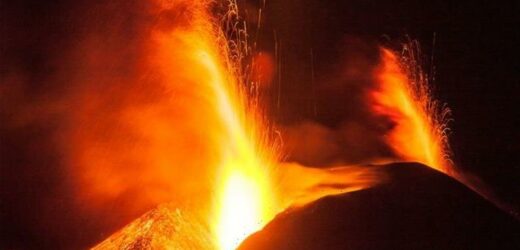La Palma: Volcano erupts and lava flows on Spanish island
We use your sign-up to provide content in ways you’ve consented to and to improve our understanding of you. This may include adverts from us and 3rd parties based on our understanding. You can unsubscribe at any time. More info
Casimiro Curbelo, president of the neighbouring La Gomera island municipality, has argued in favour of the drastic measure to prevent further destruction to La Palma. Streams of hot lava have been pouring out of the volcano since September 19 and the eruption shows no signs of slowing down. According to the latest data published by the European Union’s Copernicus Emergency Management Service (EMS), the lava flows have already destroyed more than 2,570 buildings.
As of October 31, satellites have measured the extent of lava flows at more than 975 hectares – a 5.2 hectare increase in 24 hours.
Mr Curbelo has argued during a fiery debate on a Canary Islands’ radio station for a bombing run on Cumbre Vieja.
He told Radio Faycán: “Isn’t there a plane that could fly and drop [a bomb]?
“It arrives, drops and boom. And it sends the lava in a different direction?


“Maybe it’s madness, but I get the impression from a technological point of view that it should be tried.”
Mr Curbelo’s unorthodox response to the natural disaster was met with a great deal of ridicule online.
Social media commentators tore apart his suggestion and flooded Twitter with memes.
Adrian Flores tweeted: “For all those non-Canarian people who follow me.


“Peace of mind, we have known here for a long time that Casimiro Curbelo should not be listened to.”
Others shared doctored images of the politician holding a bomb.
However, Mr Curbelo’s suggestion may not be so far-fetched, after all.
According to a report in Live Science, bombs have been dropped on volcanoes before in an attempt to control their lava flows.


When in 1935 Hawaii’s Mauna Loa volcano oozed a stream of molten rock dangerously close to the town of Hilo, the US Army dropped 20 bombs onto the lava.
Although the missions appeared to be a success at the time, scientists have long disputed whether the bombing helped at all.
According to the US Geological Survey (USGS), it is more than likely the lava stopped after the bombing as a result of pure coincidence.
The USGS said: “Regarding the success or failure of using explosives to influence the 1935 lava flow, our view is that the bombing was carried out as the eruption was already waning.”
The lava flows did not come to an abrupt stop but rather die out in the following week.
An investigation carried out in the Seventies found no thickening of the lava after the bombing despite initial reports.
The USGS added: “Volcanologists continually improve methods to forecast lava flows and the hazards they pose.
“But decisions about lava diversion must be made by local emergency managers.”
The Spanish military has reportedly not responded to Mr Curbelo’s comments.
Source: Read Full Article

